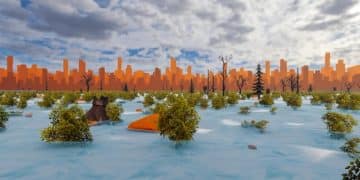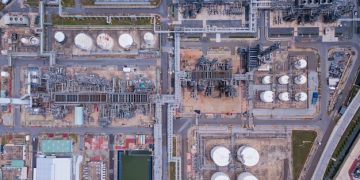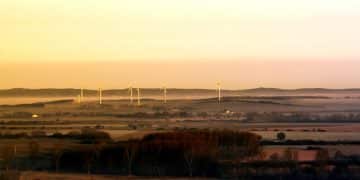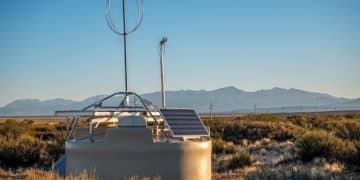Climate Change News: US Faces 2-Degree Temperature Rise by 2050

Climate Change News: Analyzing the Projected 2-Degree Temperature Rise in the US by 2050 reveals potentially devastating impacts on ecosystems, human health, and infrastructure, requiring urgent mitigation and adaptation strategies to minimize long-term consequences.
The latest Climate Change News: Analyzing the Projected 2-Degree Temperature Rise in the US by 2050 paints a stark picture of our future. With average temperatures expected to rise significantly in the coming decades, understanding the implications is crucial for informed action.
understanding the projected 2-degree temperature rise
A projected 2-degree Celsius (3.6 degrees Fahrenheit) temperature rise may seem insignificant on the surface, but it represents a substantial shift in the global climate system. This increase is an average, meaning some regions will experience much higher temperature spikes, leading to potentially catastrophic consequences. This section will delve into the primary drivers of climate change and explore why even seemingly small temperature changes can trigger significant ecological and societal disruptions in the United States.
the greenhouse effect and human activities
The greenhouse effect is a natural process that warms the Earth’s surface and makes life possible. However, human activities, particularly the burning of fossil fuels, have significantly increased the concentration of greenhouse gases in the atmosphere, trapping more heat and causing global warming. Understanding this delicate balance is crucial for comprehending the projected impacts.
climate models and projections
Climate scientists use sophisticated models to project future temperature increases based on various emission scenarios. These models analyze complex interactions within the Earth’s climate system and provide insights into potential trajectories. While uncertainties exist, the overwhelming consensus among scientists is that continued greenhouse gas emissions will lead to significant warming. Therefore, understanding the nuances of climate models is essential for informed decision-making.
- Examining the key components of climate models: atmospheric, oceanic, and land surface interactions.
- Understanding the different emission scenarios used in climate projections (e.g., RCP2.6, RCP8.5).
- Recognizing the limitations and uncertainties inherent in climate modeling.
- Exploring regional variations in projected temperature increases across the US.
In summary, a projected 2-degree Celsius temperature rise is not a minor issue; it signifies a considerable shift in the climate system driven by human activities. Climate models provide valuable insights into potential future scenarios, underscoring the urgency for proactive measures.
impacts on us ecosystems and biodiversity
The projected 2-degree temperature rise will have profound effects on US ecosystems and biodiversity. Rising temperatures exacerbate existing environmental stresses, leading to habitat loss, species extinction, and disruptions in ecosystem function. This section examines the specific impacts on different ecosystems, including forests, coastal areas, and agricultural lands.
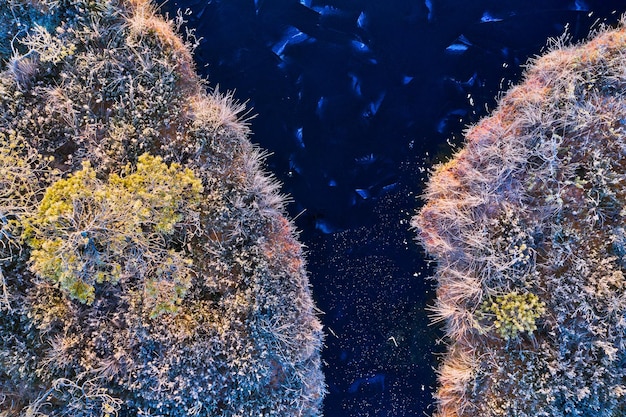
forests and wildfires
Rising temperatures increase the risk of wildfires, particularly in the western United States. Drier conditions and prolonged heat waves create ideal conditions for wildfires to ignite and spread rapidly, devastating forests and releasing massive amounts of carbon dioxide into the atmosphere. Addressing the escalating threat of wildfires is critical for preserving this ecosystem and mitigating climate change.
coastal erosion and sea level rise
Coastal areas are particularly vulnerable to the impacts of climate change. Rising sea levels, driven by thermal expansion and melting glaciers, lead to coastal erosion, inundation of wetlands, and increased risk of storm surges. These changes threaten coastal communities and ecosystems, requiring proactive adaptation strategies.
- Analyzing the impacts on specific ecosystems: coral reefs, wetlands, and alpine meadows.
- Identifying vulnerable species that are at risk of extinction due to climate change.
- Exploring the potential for ecosystem restoration to enhance resilience to climate change.
- Evaluating the economic costs associated with biodiversity loss.
In conclusion, the 2-degree temperature rise presents a significant threat to US ecosystems and biodiversity. Rising temperatures exacerbate existing environmental stresses, leading to habitat loss, species extinction, and disruptions in ecosystem function.
effects on human health and well-being
The impacts of climate change extend beyond the environment and directly affect human health and well-being. Rising temperatures increase the risk of heat-related illnesses, respiratory problems, and the spread of infectious diseases. This section explores these health impacts in detail, focusing on vulnerable populations and potential adaptation strategies.
heat waves and heat-related illnesses
Heat waves are becoming more frequent and intense due to climate change, posing a significant threat to human health. Prolonged exposure to extreme heat can lead to heatstroke, dehydration, and other heat-related illnesses, particularly among the elderly, children, and individuals with chronic health conditions. Therefore, implementing heat-health action plans is crucial for protecting vulnerable populations.
respiratory problems and air quality
Climate change worsens air quality, increasing the risk of respiratory problems. Rising temperatures promote the formation of ground-level ozone, a major component of smog that can trigger asthma attacks and other respiratory ailments. Additionally, wildfires release harmful pollutants into the air, further exacerbating respiratory problems.
the spread of infectious diseases
Climate change can alter the distribution and transmission of infectious diseases. Warmer temperatures and changes in precipitation patterns can expand the geographic range of disease-carrying vectors, such as mosquitoes and ticks, increasing the risk of vector-borne diseases like West Nile virus and Lyme disease.
- Analyzing the impacts on food security and nutrition due to changing agricultural conditions.
- Evaluating the mental health impacts of climate change, including stress, anxiety, and depression.
- Identifying strategies to reduce vulnerability to climate-related health risks, such as improving access to healthcare.
- Exploring the role of public health agencies in addressing climate change.
In conclusion, climate change has numerous direct and indirect effects on human health and well-being, necessitating comprehensive adaptation strategies, especially for vulnerable communities.
impacts on infrastructure and economy
The projected 2-degree temperature rise will have substantial impacts on critical infrastructure and the US economy as a whole. Rising sea levels, extreme weather events, and disruptions to supply chains threaten infrastructure systems, while economic sectors like agriculture, tourism, and energy production face significant challenges. This section examines these impacts in detail.
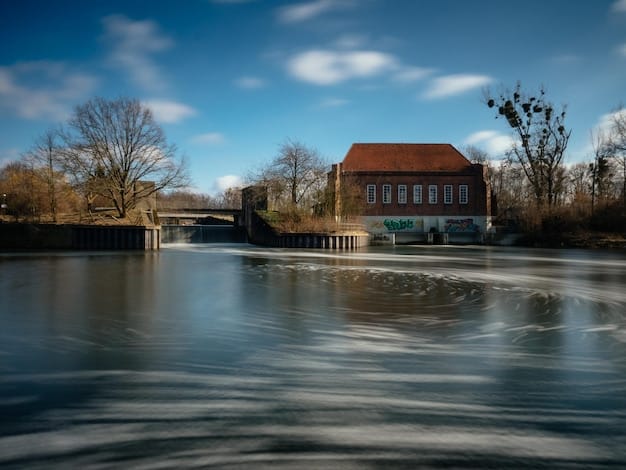
sea level rise and coastal infrastructure
Rising sea levels threaten coastal infrastructure, including roads, bridges, ports, and wastewater treatment plants. Coastal erosion and inundation can damage or destroy these assets, disrupting transportation, commerce, and public services. Investing in coastal protection measures is essential for mitigating these risks.
extreme weather events and infrastructure resilience
Climate change intensifies extreme weather events, such as hurricanes, floods, and droughts, which can overwhelm infrastructure systems. Strengthening infrastructure resilience through improved design, construction practices, and maintenance is crucial for minimizing disruptions and ensuring the safety of communities. Failure to adapt could result in potentially devastating impacts for the US economy.
economic impacts on key sectors
The 2-degree temperature rise will have far-reaching economic impacts on key sectors. Agriculture is particularly vulnerable to climate change, with rising temperatures, changes in precipitation patterns, and increased risk of pests and diseases affecting crop yields and livestock production. Tourism, energy production, and manufacturing will also face challenges. Implementing strategies to minimize potentially devastating impacts on the US economy is required.
- Evaluating the economic costs associated with climate change impacts on infrastructure.
- Identifying opportunities for green infrastructure investments to enhance climate resilience.
- Analyzing the impacts on water resources and potential conflicts over water allocation.
- Exploring the insurance industry’s role in managing climate risks.
In conclusion, the 2-degree temperature rise poses significant challenges to US infrastructure and the economy, requiring proactive adaptation measures and sustainable development practices.
mitigation and adaptation strategies
Addressing the projected 2-degree temperature rise requires a combination of mitigation and adaptation strategies. Mitigation focuses on reducing greenhouse gas emissions to slow down the rate of warming, while adaptation involves adjusting to the impacts of climate change that are already occurring or are unavoidable. This section explores various mitigation and adaptation options.
reducing greenhouse gas emissions
The most effective way to mitigate climate change is to reduce greenhouse gas emissions. This can be achieved through a variety of measures, including transitioning to renewable energy sources, improving energy efficiency, promoting sustainable transportation, and reducing deforestation. Therefore, implementing aggressive emissions reductions targets is critical for limiting future warming.
adaptation measures for vulnerable regions
Adaptation measures are crucial for protecting vulnerable regions and communities from the impacts of climate change. These measures include building seawalls to protect coastal areas, developing drought-resistant crops, improving water management practices, and implementing heat-health action plans. Strengthening community resilience is essential for coping with the inevitable impacts of climate change.
the role of policy and international cooperation
Effective climate action requires strong policy support and international cooperation. Governments can implement policies to incentivize emissions reductions, promote adaptation measures, and invest in climate research. International agreements, such as the Paris Agreement, provide a framework for global cooperation to address climate change.
- Analyzing the costs and benefits of different mitigation and adaptation strategies.
- Identifying innovative technologies that can contribute to climate solutions.
- Discussing the ethical dimensions of climate change and the need for equitable solutions.
- Exploring the potential for carbon capture and storage technologies.
In conclusion, mitigating climate change and adapting to its impacts requires a comprehensive approach that combines emissions reductions, adaptation measures, policy support, and international cooperation.
the future outlook and potential scenarios
The future outlook for climate change depends on the actions we take today. If greenhouse gas emissions continue to rise unabated, the projected 2-degree temperature rise could be exceeded, leading to even more severe consequences. This section explores different potential scenarios and emphasizes the importance of ambitious climate action.
best-case and worst-case scenarios
Climate models can be used to project a range of possible future scenarios, from best-case scenarios where emissions are rapidly reduced to worst-case scenarios where emissions continue to rise unchecked. Analyzing these scenarios can help us understand the potential consequences of our choices and inform decision-making. A future where emissions are reduced may offer humanity a better chance to thrive than the alternative.
the importance of ambitious climate action
Ambitious climate action is essential for avoiding the worst impacts of climate change. This requires a global effort to reduce emissions, adapt to the impacts of climate change, and build a more sustainable future. Delaying action will only increase the risks and costs of climate change.
individual actions and community engagement
While policy and international cooperation are essential, individual actions and community engagement also play a crucial role. Individuals can reduce their carbon footprint by making sustainable choices in their daily lives, such as conserving energy, using public transportation, and reducing their consumption of meat. Community engagement can help raise awareness, build support for climate action, and promote local solutions.
- Discussing the potential for technological breakthroughs to accelerate climate solutions.
- Exploring the role of education in promoting climate literacy and empowering individuals to take action.
- Analyzing the social and political barriers to climate action and strategies to overcome them.
- Highlighting success stories of communities and countries that are leading the way on climate action.
In conclusion, the future is not predetermined, and the choices we make today will determine the severity of climate change impacts. Ambitious climate action, combined with individual actions and community engagement, can help create a more sustainable and resilient future.
| Key Point | Brief Description |
|---|---|
| 🔥 Temperature Rise | Projected 2°C rise in the US by 2050. |
| 🌊 Ecosystem Impacts | Threats to forests, coastal areas, and biodiversity. |
| ⚕️ Human Health Risks | Increased heat waves, respiratory issues, and disease spread. |
| 💰 Economic Challenges | Impacts on infrastructure, agriculture, and tourism. |
FAQ
▼
The primary cause is the increase in greenhouse gas emissions, which trap heat in the atmosphere. These emissions mainly come from burning fossil fuels for energy and industrial processes.
▼
Coastal cities face increased flooding and erosion due to rising sea levels. Infrastructure in these areas will be at higher risk, and there could be significant displacement of populations.
▼
Adaptation measures focus on resilience, such as building sea walls, improving water management, and developing drought-resistant crops. Infrastructure improvements are also key to protecting against damage.
▼
Transitioning to renewable energy sources like solar and wind is crucial for reducing greenhouse gas emissions. This shift can help slow down the rate of warming and lessen the severity of future impacts.
▼
Individuals can make sustainable choices, such as conserving energy, using public transportation, and reducing meat consumption. Supporting policies that promote climate action can also make a difference.
Conclusion
The projected 2-degree temperature rise presents a formidable challenge, but with concerted efforts towards mitigation and adaptation, the worst impacts can be avoided. By embracing sustainable practices and supporting strong climate policies, the US can strive towards a more resilient and sustainable future for all.
